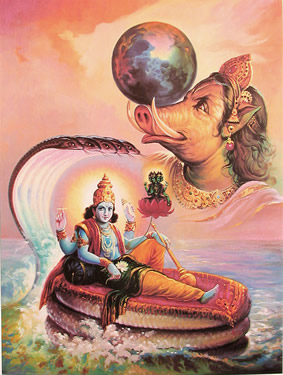 |
Essence Of
Varaha Purana
|
| 34 Procedure of Maha Vishnu Vratha | |
Varaha Deva explained to Prithi Devi that even the worst kind of Sins, (including the ‘Pancha Pathakas’ or the Five Worst Sins viz. killing Brahmana, Wine drinking, falsehood, committing thefts, and incest with Guru’s wife) could be destroyed, progeny and prosperity are blessed, health and fame are assured and longevity and contentment are augmented, provided Vishnu Puja is carried out with purity of body and soul. The Vrath to be executed in the Month of Kartika during the Bright fortnight on Dwitheeya or Samkranthi Dwadasi or during Chandra Grahan or Surya Grahan ( Lunar or Solar Eclipses). As per prescribed Procedure in the Varaha Purana, Lord Vishnu and Devi Lakshmi are installed in the midst of sixteen or atleast nine petals of Lotus as directed by Guru (Preceptor). Intiation of the Vratha should be on Kartik Shukla Dashami itself by taking fruits and milk and rest overnight in the presence of the Installed Deities and the Guru. Now, the nine (or sixteen) mandals be arranged in bright colours installing Loka Palas first viz. Indra in East and worship him; Agni in his direction or Agnikona or Agneya and worship him; Yamaraja in South and Nirruti; Varun in West, Vayu in Vayavya kona; Kuber in North and Rudra in Ishanya. Likewise, install in the middle of the Lotus, Lord Vishnu. Also, Balaram be worshipped on the Eastern Patra; Pradyumna on the Southern Patra; on the West Aniruddha and on the North the sin-destroyer Vasudeva. In the Eshana Kona be installed Shankha and in Agni kona the Chakra, Dakshin side the Mace (Gada), Vayavya kona Padma; in Ishaan kona Musalam be worshipped and in the South Garuda; on the left side of Maha Deva be installed Devi Lakshmi; facing the Chief Deity of Vishnu be installed Dhanush, Khadga, Sri Vatsa and Koustubh. Subsequently, eight Kumbh or pots be arranged in ten dishas (Directions); of these Vishnu-related nine kumbhs be installed and perform bathing to any one Murthi as convenient. In the same way, bathe Indra’s Ghat in the name of Ishvarya or Prosperity; those devotees who are keen on money and valour might bathe the Agni-related kumbh; those desirous of victory against death would bathe Yamadharmaraja; seekers of peace of mind might bathe into the Ghata of Varun; for instant erasure of sins, bathe the pot of Vayu; for immediate money bathe the pot of Kubera; for Gyan to Rudra. After these preliminaries, the Guru would advise all the Sishyas either of Self or of Guru that Brahmanas should be respected always as they were of Vishnu Swarup! Then would commence the ‘Homas’ or oblations to Agni by uttering the Shodasakshara Mantra: Om Namo Bhagavatey Sarva Swarupiney hum phat Swaha / [After the Homas are executed, then follows the chapter of ‘Dakshinas’. While those who could afford such as Kings and rich persons of the clans of Kshatriyas and Vaisyas engaged in business, the middle class persons might satisfy the Gurus and Brahmanas according to the proven levels of knowledge as also the affording capacity of the devotees concerned, without overcharging by the receivers as per demand and supply forces nor underpaying the learned despite affordability.] Performing the Vratha, participating directly or otherwise, or observing the Proceedings with keenness or atleast having a ‘Darshan’ of the ‘Mandala’ Area and of the Deities would all yield proportionate blessings and boons! | |
 Prev:‘Kapala Vimochan’ and Rudra Vratha Prev:‘Kapala Vimochan’ and Rudra Vratha | |
 Next:‘Kapala Vimochan’ and Rudra Vratha
Next:‘Kapala Vimochan’ and Rudra Vratha